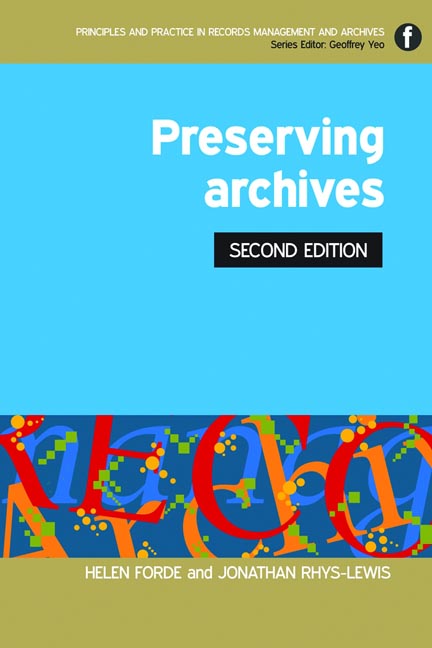Book contents
- Frontmatter
- Contents
- Introduction to the series Geoffrey Yeo
- Preface to the Second Edition
- Acknowledgements
- 1 Introducing archive preservation
- 2 Understanding archival materials and their characteristics
- 3 Managing digital preservation
- 4 Archive buildings and their characteristics
- 5 Safeguarding the building and its contents
- 6 Managing archival storage
- 7 Managing risks and avoiding disaster
- 8 Creating and using surrogates
- 9 Moving the records
- 10 Exhibiting archives
- 11 Handling the records
- 12 Managing a pest control programme
- 13 Training and the use of volunteers
- 14 Putting preservation into practice
- Appendices
- Bibliography
- British and international standards relating to archive preservation
- Index
8 - Creating and using surrogates
Published online by Cambridge University Press: 09 June 2018
- Frontmatter
- Contents
- Introduction to the series Geoffrey Yeo
- Preface to the Second Edition
- Acknowledgements
- 1 Introducing archive preservation
- 2 Understanding archival materials and their characteristics
- 3 Managing digital preservation
- 4 Archive buildings and their characteristics
- 5 Safeguarding the building and its contents
- 6 Managing archival storage
- 7 Managing risks and avoiding disaster
- 8 Creating and using surrogates
- 9 Moving the records
- 10 Exhibiting archives
- 11 Handling the records
- 12 Managing a pest control programme
- 13 Training and the use of volunteers
- 14 Putting preservation into practice
- Appendices
- Bibliography
- British and international standards relating to archive preservation
- Index
Summary
Introduction
Surrogates – the production of a user copy of the original – have a major role in preservation management, as they reduce the wear and tear on originals and in many cases enhance access. Developing a programme should therefore be an option for all archives, but it must be recognized that all interests, including those of the readers, should be taken into account. Policy decisions will have to be considered if surrogates are to be offered to readers; will it be obligatory to use them and are there copyright issues, especially if they are available online? These issues need to be debated and agreed by the archive, since they will undoubtedly be raised at some point by readers.
Debates about different methods, the reasons for copying, and the associated costs of creation and upkeep have ranged widely over the past 50 years. Until recently such discussions have been centred largely on copying for the purposes of preservation. Access issues, however, have always crept in, emphasizing the difficulty of isolating one from the other. The development of digital methods of copying information has given increasing prominence to access issues, leading to change and enlargement of archive and library access policies, plans and costs. These are issues which are likely to loom larger in the future. Preservation is no longer the main focus.
This chapter looks at:
• the different types of copies
• the preservation issues surrounding the creation of surrogates
• the changing policies of archives on copying
• the actions needed to ensure that original materials are treated appropriately if they are copied.
It does not describe the technical requirements or standards for equipment, which can be found in the appropriate manuals.
Copying archive material
Reformatting for preservation whether utilizing analog or digital technologies is a series of choices all affected by economics, legal or social conventions, and decisions about risk management.
(Bellinger, 2003)Decisions to copy, as Bellinger states, involve a host of choices, all of which require judgement about condition and access, and some of which may be controversial. Nevertheless, they must be made and priorities established; the alternative could be the total loss of information and therefore access to it. Risk management looms large in debates about copying.
- Type
- Chapter
- Information
- Preserving Archives , pp. 123 - 138Publisher: FacetPrint publication year: 2013

